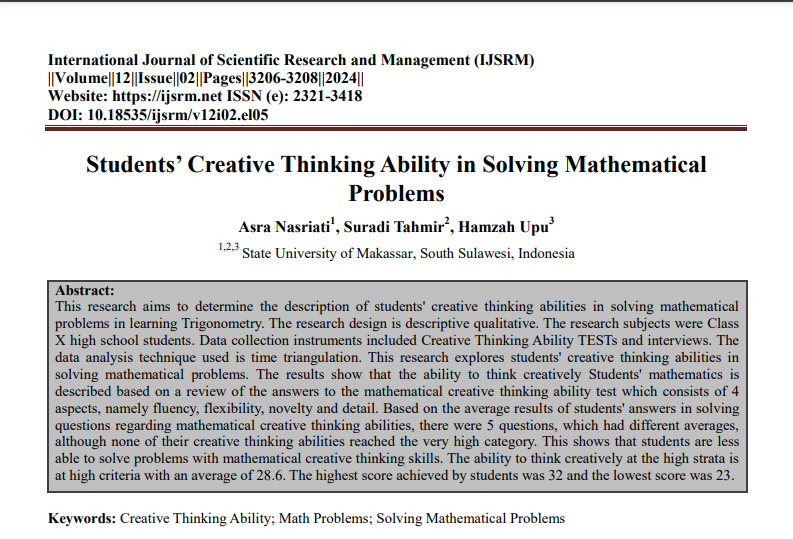
Submission to VIJ 2024-02-22
Keywords
- Creative Thinking Ability; Math Problems; Solving Mathematical Problems
Copyright (c) 2024 Asra Nasrianti, Suradi Tahmir, Hamzah Upu

This work is licensed under a Creative Commons Attribution 4.0 International License.
Abstract
This research aims to determine the description of students' creative thinking abilities in solving mathematical problems in learning Trigonometry. The research design is descriptive qualitative. The research subjects were Class X high school students. Data collection instruments included Creative Thinking Ability TESTs and interviews. The data analysis technique used is time triangulation. This research explores students' creative thinking abilities in solving mathematical problems. The results show that the ability to think creatively Students' mathematics is described based on a review of the answers to the mathematical creative thinking ability test which consists of 4 aspects, namely fluency, flexibility, novelty and detail. Based on the average results of students' answers in solving questions regarding mathematical creative thinking abilities, there were 5 questions, which had different averages, although none of their creative thinking abilities reached the very high category. This shows that students are less able to solve problems with mathematical creative thinking skills. The ability to think creatively at the high strata is at high criteria with an average of 28.6. The highest score achieved by students was 32 and the lowest score was 23.
References
- Afifah & Asikin. 2018. Mathematical creative thinking skills in a Creative Problem Solving learning setting with an Open-Ended Approach, in the Ahmad Dahlan National Seminar on Mathematics Education.
- Ministry of Education and Culture. (2016). Minister of Education and Culture Regulation Number 22 of 2016 concerning Content Standards for Primary and Secondary Education.
- Maharani, Hevy Risqi. 2014. Creative Thinking In Mathematics: Are We Able to Solve Mathematical Problems in a Variety of Ways?. International Conference on Mathematics, Science, and Education.
- Mahmudi, Ali. 2010. Measuring Mathematical Creative Thinking Ability, in the XV National Conference on Mathematics.
- NCTM. (2000). Principles and Standards for School Mathematics.
- Sternberg, R. J. (2006). Creativity: An investment in human capital.
- Supriatna, N. (2012). Improving Junior High School Students' Creative Mathematical Thinking Ability through Problem Based Learning. Journal of Mathematics Education, 3(2), 131-140